#nobuyasu matsudaira
Text
Reviewing resources
This is more of a research log/review, rather than an article proper (since this is still somewhat inconclusive)
I was rereading about how the story of Nobunaga ordering the deaths of Ieyasu’s wife and son was partly contradicted by the Shinchoukouki alternative manuscripts (Azuchi Nikki), where Oota Gyuuichi originally included a passage where Nobunaga actually did no such thing.
Gyuuichi wrote that Nobuyasu is plotting treason, and Tokugawa vassals came to Nobunaga to discuss the issue, and all that came out of it was the decision to exile Nobuyasu. The narrative was changed slightly multiple times across different copies of the manuscripts, until eventually it was just removed altogether in the final compilation.
(material presented by the Hamamatsu City historical research archives)
As it turns out, this historical research paper actually used Gyuuichi’s texts to prove the opposite: That Nobunaga’s order to kill Nobuyasu and Tsukiyama-dono was true!
However, that selected citation alone doesn’t prove or disprove much beyond “Nobunaga discussed the matter of Nobuyasu with Tokugawa vassals”. It’s vague enough that those researchers and myself took the text to be bolsters for completely opposite arguments.
It’s possible that the Hamamatsu research team was operating on the preconceived bias that “Mikawa Monogatari must be true”, as this research document was from 1971. The counter-argument materials I presented in my other post came from much more recent research works due to additional materials being discovered, or newer angles of analysis being considered. Older research works seems to have the tendency to more strongly trust the Edo period documentation.
Prof. Owada Tetsuo, for example, wrote an article in 2012 saying he suspected that “Gotoku’s letter accusing Nobuyasu and Tsukiyama of colluding with Takeda” is unreliable narrative.
It would be nice if the Azuchi Nikki has a proper full transcript in modern language so I can review them. Even if there really is nothing concrete there, I at least want to confirm what exactly was on the paper.
#owada tetsuo#tokugawa nobuyasu#matsudaira nobuyasu#tsukiyama dono#tsukiyama-dono#research#personal reflection#oota gyuuichi
3 notes
·
View notes
Photo
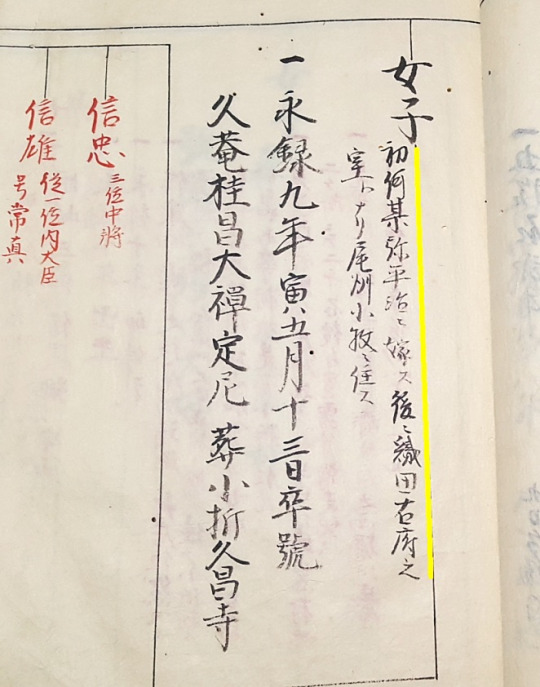

Ikoma-san also pointed out that the whole story about “Kitsuno”’s former husband being “Tsuchida Yaheiji” who died is an utter fraud because it originated in Bukouyawa.
There is no such thing as a Tsuchida surname in that time according to him.
Also, in the Ikoma clan genealogy it was written that Kitsuno’s first husband is “some dude named Yaheiji”. No surname is written. This is Not How That Works. The other ladies’ husbands are written clearly. Tokuhime’s husband is written as Okazaki Nobuyasu, not Matsudaira or Tokugawa, for some reason. Maybe Yasu disowned him posthumously IDK. But that is still a name.
Also Kitsuno’s sister is married to “Oda” something. I can’t read the word that comes after it. It’s Oda Roku-something Saburou?
At any rate. “Some dude” is weird.
So that’s why Ikoma-san thought this “some dude named Yaheiji” fellow is Akechi Hidemitsu. Hidemitsu used to go by the name Yaheiji (and a different surname). After Honnouji, Akechi’s name Must Not Be Named, so there is a reasonable motive to not name the surname. Since he obviously wasn’t dead yet when Kitsuno became Nobu’s concubine, they were probably just divorced.
Oh, the drama. Oh, the irony.
#Akechi Hidemitsu as he stormed Honnouji#HOW DARE YOU STEAL MY WIFE ALL THOSE YEARS AGO ASSHOLE#sengoku#honk honk#make this as dramatic as a telenovela#with lots of crying#nobunobu
5 notes
·
View notes
Text
[History] This Song But--
This song but make it Lady Tsukiyama after Ieyasu secured his alliance with Nobunaga
Lady Tsukiyama, crying on the Hamamatsu Castle’s hallway : CAN I JUST STAY HERE?! SPEND THE REST OF MY DAYS HERE?!
Ieyasu, back facing Lady Tsukiyama : ...
Or we can make it as Nobuyasu before Ieyasu exiled him to Futamata Castle!
#history#japanese history#sengoku hustle#sengoku era#Talk with the Lady#ieyasu#tokugawa ieyasu#ieyasu tokugawa#lady tsukiyama#sena#matsudaira nobuyasu#nobuyasu matsudaira
2 notes
·
View notes
Text
reading about how tadakatsu and naomasa are often regarded as a contrasting pair bc tadakatsu was said to have been so strong he never got wounded while naomasa, despite receiving many wounds, battled through them and was still so strong his subordinates feared him
#like ohh yeah......#also apparently actual tadatsugu did not like nobuyasu but nikkari!tadatsugu was like nope! this is my son#i gather kishou is about tonbo and muramasa since tadakatsu and naomasa were the last to die#and also akashi was owned by the matsudaira so.#gemitus#tkrb#toumyu
3 notes
·
View notes
Photo
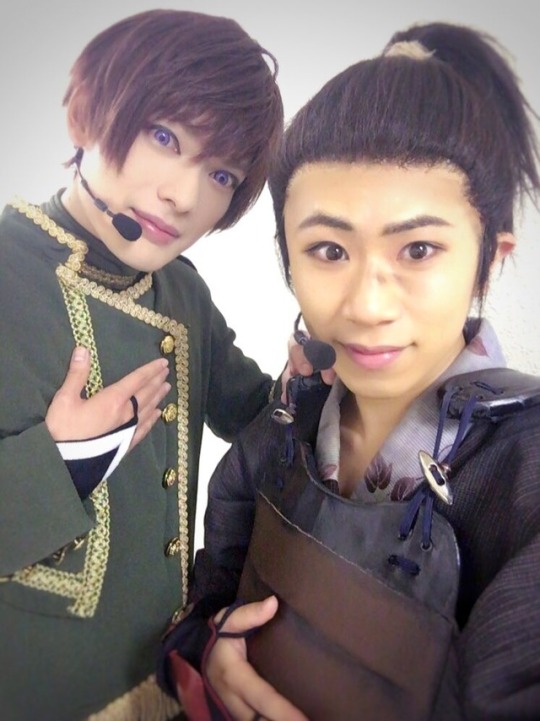


Other photos I’ve forgotten to post! xD Some of them are from a few days ago and the others were from yesterday!
Sakiyama Tsubasa as Ishikirimaru
Takane Masaki as Gohei
Tochihara Rakuto as Okita Souji
Waisho Noboru as Tokugawa Ieyasu
Tagaki Tomoyuki as Hijikata Toshizou
Kako Rion as Fujiwara no Yasuhira
Gomoto Naoya as Kondou Isami
Ono Mizuki as Matsudaira Nobuyasu
Sources: HERE, HERE & HERE
#Touken Ranbu#Musical Touken Ranbu#Toumyu#Shinken Ranbu Sai 2017#SRS2017#Ishikirimaru#Sakiyama Tsubasa#Gohei#Takane Masaki#Okita Souji#Tochihara Rakuto#Tokugawa Ieyasu#Waisho Noboru#Hijikata Toshizou#Tagaki Tomoyuki#Fujiwara no Yasuhira#Kako Rion#Kondou Isami#Gomoto Naoya#Matsudaira Nobuyasu#Ono Mizuki#Twitter
54 notes
·
View notes
Text
The True Cost of an Alliance
So for anyone who doesn’t know I am unapologetically a fan of the Sengoku Musou/Samurai Warriors series. While It was actually the series Kessen that got me into the Sengoku Period to begin with it was Sengoku Musou that really helped keep me interested in the era. With Samurai Warriors 5 coming this year and the introduction of a rather unexpected character named Sena (whom I will be referring to as Lady Tsukiyama) I thought this would be the perfect time to discuss one of the most infamous incidents of the period.
This is a facts tumblr so I’m not going to really touch on them until after the story is done, but I will start by saying that this event has spawned several tales of both ghosts and curses throughout Japanese history. Now that I have your attention let me set the scene for you. It is the year 1579. Oda Nobunaga and his clan have taken over all of central Japan. To the West is the Mori clan, and to the East is the Uesugi. The mighty Takeda clan had been decimated at the battle of Nagashino and the Oda-Tokugawa alliance was taking over more and more Takeda land by the year. While the Takeda’s home province of Kai would not fall for another four years, no one would consider the Takeda clan a viable opponent to the Oda-Tokugawa alliance at this point.
Nobunaga’s alliance with Ieyasu, forged after the fall of the Imagawa in 1560 and sealed three years later in 1563 by a marriage of Nobunaga’s five year old daughter Tokuhime to Ieyasu’s five year old son Nobuyasu was considered unparalleled at this point. However, in 1579 Ieyasu would learn the true cost of this alliance. His eldest son Nobuyasu was considered a rising star in Japanese politics. He seemed to have a natural talent for leadership and battle alike and was being perfectly groomed by Ieyasu to be the next head of the Tokugawa clan. He had a loving wife whom he treated well and was said to be quite popular across the Tokugawa and Oda controlled provinces. Ieyasu even put Nobuyasu in charge of his home castle, Okazaki. Nobuyasu was deeply loved by his father and adored by his mother Lady Tsukiyama. So much so, in fact, that his wife Tokuhime apparently had a long standing grudge with her mother in law. While we don’t know the exact reason some speculate that the two butted heads quite a bit over what was best for Nobuyasu, how Tokuhime could be a better wife, and what Tokuhime could and couldn’t do to properly respect her inlaws. One tale states that Tokuhime only gave birth to two daughters for Nobuyasu and failed to produce an heir. Wanting a grandson Lady Tsukiyama arranged for the daughter of a Takeda retainer to become Nobuyasu's concubine in hopes of the concubine having a son. While this certainly wasn’t unheard of at this time it apparently this didn’t sit well with the 21 year old.
I want to take a brief pause to say that some sources also say that Tokuhime and Nobuyasu’s marriage was horrible, Nobuyasu was a mama’s boy, he never took his wife’s side and despised her for arguing with his mother, etc. etc. but we can’t verify any of that and given that Tokuhime didn’t seem to have any direct problem with Nobuyasu himself I’m going to say this was unlikely. Anyway, back to the story of Nobunaga’s angry daughter.
Deciding she had enough of her mother in law’s interference into her marriage Tokuhime wrote a letter to her father. For anyone who knows about Nobunaga, I’m sure you’ve realized this can’t go anywhere good. Tokuhime told her father that since the concubine was from the Takeda, clearly Ieasyu’s wife was colluding with the Takeda forces and had been in direct contact with Takeda Katsuyori to undermine the Oda-Tokugawa alliance and possibly even get the Tokugawa to switch sides. Obviously this didn’t sit well with Nobunaga and Nobunaga demanded that in order to keep the Oda-Tokugawa alliance alive Ieyasu would have to execute his wife.
Understanding how important the alliance was, being aware that his son had in fact received a Takeda clan daughter as a concubine, and not wanting a war to break out in which he would be pinned between the Oda, Hojo, and Takeda, Ieyasu agreed. On 9 September 1579, Lady Tsukiyama (Sena in Samurai Warriors 5) was beheaded on the shore of Lake Sanaru, in Hamamatsu on Ieyasu’s order. Her primary grave is at Seiryū temple in Hamamatsu. However, her head rests in Hachioji Shrine. Sadly the tragedy doesn’t stop there. Remember the entire point of this was to maintain the Oda-Tokugawa alliance. Nobuyasu now had a reason to despise the Oda and when he became head of the Tokugawa household would likely have no sympathy if the Oda ever found themselves in danger. Knowing that his son would now have a grudge Ieyasu would also order his first born son, the rising star Nobuyasu, to commit seppuku. This meant Tokuhime would live the rest of her days as a widow, returning to the Oda clan and that leadership of the Tokugawa after Ieyasu died would go to Tokugawa Hidetada. ultimately this would prove a good thing as it would mean Hidetada’s son Iemitsu would become Shogun. Though we are left to wonder how history may have changed if Nobuyasu had been allowed to live or if his wife never sent that letter to Nobunaga.
Now as I said at the opening this in and of itself isn’t a ghost story. However, for the next 400+ years several tales would arise of seeing the ghosts of Lady Tsukiyama and Matsudaira Nobuyasu. When Nobunaga died a few years later at the hands of his retainer Akechi Mitsuhide some would say it was Lady Tsukiyama’s curse. Some would even go so far as to say that it was actually planned out by the Akechi and Tokugawa together in revenge for the loss of Ieyasu’s son and wife. Even when it came to Ieyasu losing the battle of Komaki and Nagakute it would be labeled as his late wife’s curse. Just like at any point throughout history whenever something bad happened to the Oda or the Tokugawa people would be quick to find a horrible story from the past and claim that it must be a curse from someone involved with that event.
Will Sena’s fate be the same in Samurai Warriors 5? I doubt it. Koei tends to leave out particularly gruesome things like this from their titles. However, it will be curious to see what fate they have in store for Ieayasu’s wife and how long she lasts within the game’s world. Though, some of you may recognize this story from Nioh 1 as the wraith of Lady Tsukiyama appears as a demon mourning the death of her son before attacking William.
#sengoku musou#samurai warriors#samurai warriors 5#sengoku musou 5#oda nobunaga#nobunaga oda#nobunaga#ieyasu tokugawa#tokugawa ieyasu#oda clan#tokugawa clan#oda#tokugawa#sengoku#Sengoku Era#sengoku jidai#samurai fun facts#samurai facts#samurai#sena#nioh#nioh collection#nioh 1
29 notes
·
View notes
Photo


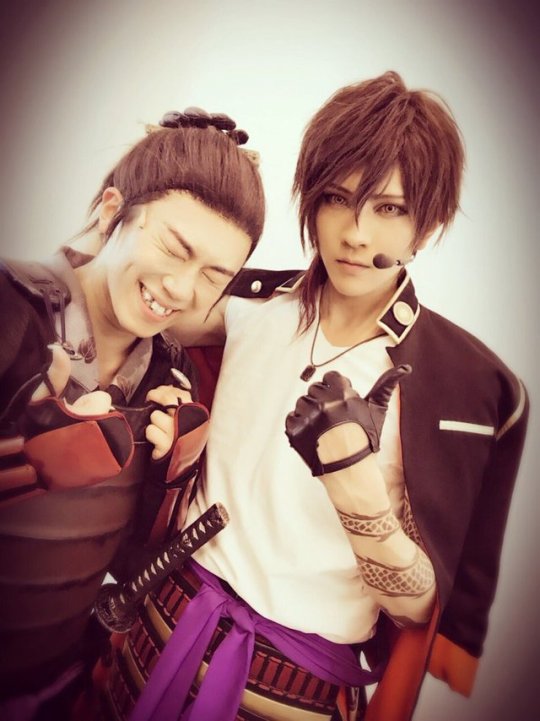
ARE YOU KIDDING ME?????? ToT
Source : 1, 2, 3
#I'm not crying you're crying#Musical : Touken Ranbu Mihotose no Komori Uta#Ishikirimaru#Matsudaira Nobuyasu#Ookurikara#Gohei#Sakiyama Tsubasa#Ohno Mizuki#Zaiki Takuma#Takane Masaki#Twitter
57 notes
·
View notes
Photo
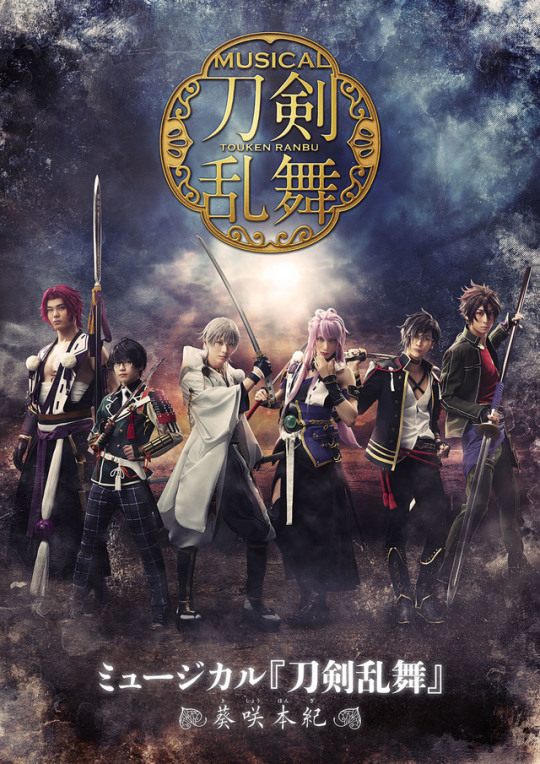
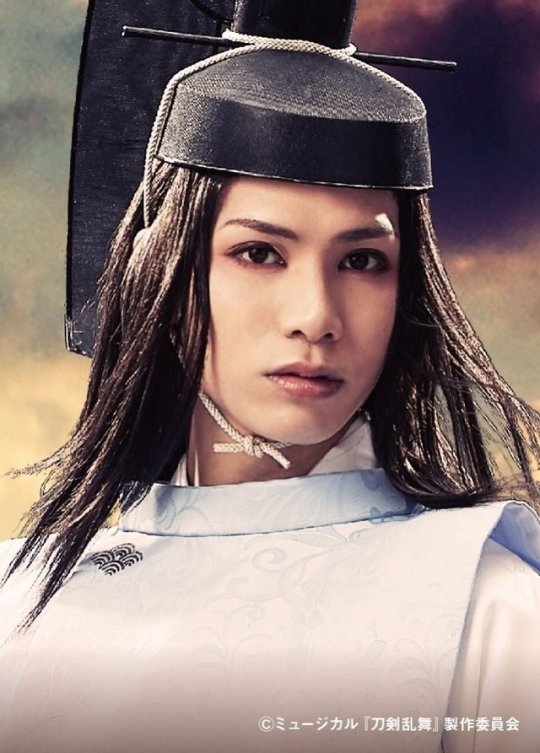

[Pics] ミュージカル『刀剣乱舞』 ~葵咲本紀~ (musical touken ranbu ~kishouhongi~)
visuals update under the cut^^
Cast:

Nakada Hiroki Asakashi Kuniyuki (明石国行)

Oota Motohiro as Sengo Muramasa (千子村正)

Spi as Tonbokiri (蜻蛉切)

Okamiya Kurumu as Tsurumaru Kuninaga (鶴丸国永)

Tanaka Ryousei as Otegine (御手杵)

Tamura Shougo as Kotegiri Gou (篭手切江)
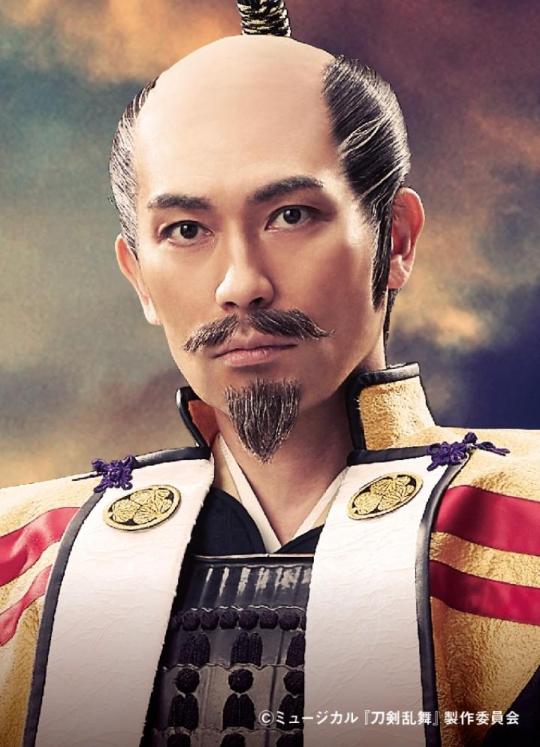
Washio Noboru as Tokugawa Ieyasu (徳川家康)
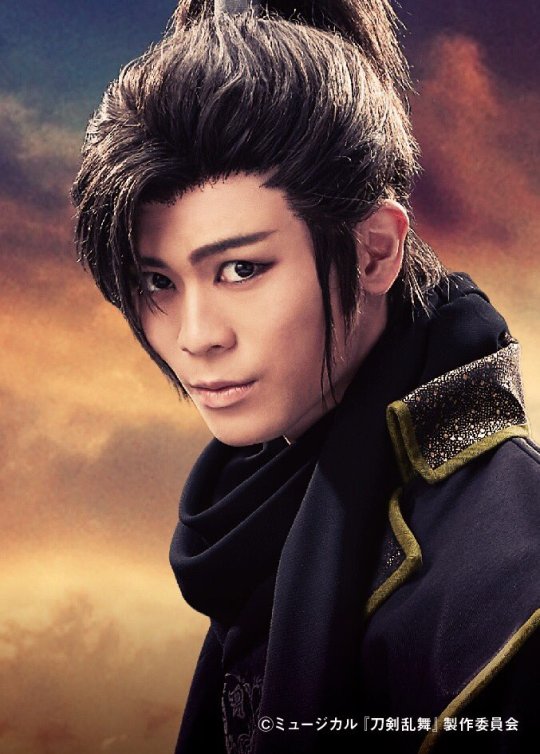
Oono Mizuki as Matsudaira Nobuyasu (松平信康)

Futaba Yuu as Nagami Sadachika (永見貞愛)
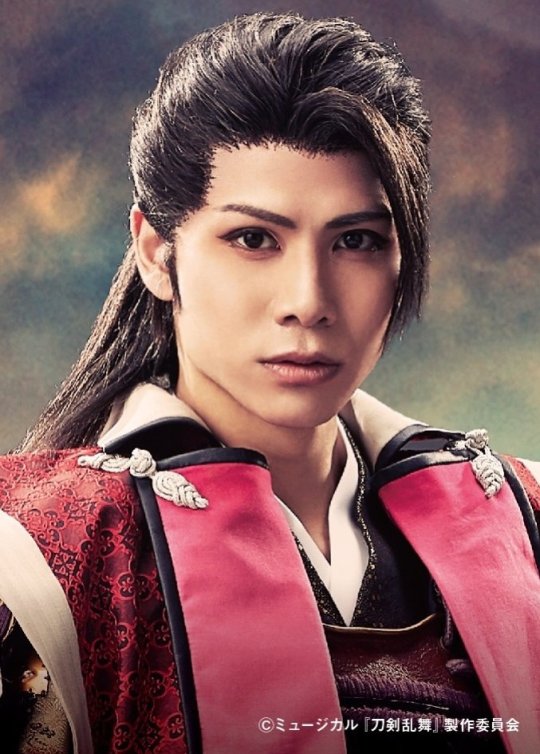
Futaba Kaname as Yuuki Hideyasu (結城秀康)
Harashima Motohsa as Tokugawa Hidetada (徳川秀忠)
homepage
twitter (x) (x) (x)
#ミュージカル 刀剣乱舞#musical touken ranbu#刀剣乱舞#touken ranbu#toumyu#仲田博喜#nakada hiroki#太田基裕#oota motohiro#spi#岡宮来夢#okamiya kurumu#田中涼星#tanaka ryousei#田村升吾#tamura shougo#鷲尾昇#washio noboru#大野瑞生#oono mizuki#二葉勇#futaba yuu#二葉要#futaba kaname#原嶋元久#harashima motohisa
55 notes
·
View notes
Photo
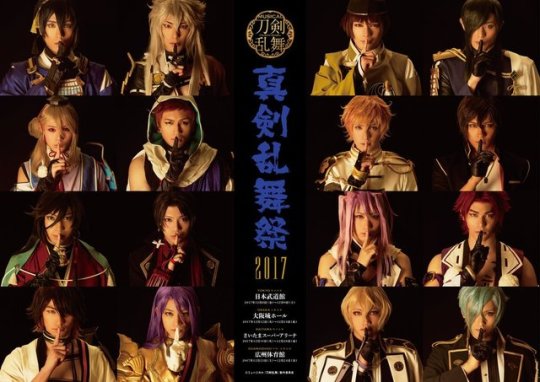
MUSICAL TOUKEN RANBU SHINKEN RANBU SAI 2017 SUB INDONESIA
Cast :
Mikazuki Munechika: Kuroba Mario
Kogitsunemaru: Kitazono Ryo
Ishikirimaru: Sakiyama Tsubasa
Iwatooshi: Saeki Daichi
Imanotsurugi: Oohira Shunya
Kashuu Kiyomitsu: Satou Ryuuji
Izuminokami Kanesada: Arisawa Shotarou
Hachisuka Kotetsu: Takahashi Kensuke
Nagasone Kotetsu: Imari Yuu
Nikkari Aoe: Araki Hirofumi
Sengo Muramasa: Oota Motohiro
Tonbokiri: Spi
Monoyoshi Sadamune: Yokota Ryuugi
Ookurikara: Zaiki Takuma
Higekiri: Miura Hiroki
Hizamaru: Takano Akira
Musashibou Benkei : Tanaka Shigemi
Minamoto no Yoshitsune : Araki Kentarou
Minamoto no Yoritomo : Okuno Masaaki
Fujiwara no Yasuhira : Kako Lion
Kondou Isami : Goumoto Naoya
Hijikata Toshizou : Tagaki Tomohiro
Okita Souji : Tochihara Rakuto
Tokugawa Ieyasu : Washio Noboru
Matsudaira Nobuyasu : Ohno Mizuki
Takechiyo: Ayuba Shuri / Kojima Yukito
Gohei : Takane Masaki
Rules :
Ask/PM untuk videonya kalau belum punya.
Disarankan menggunakan pemutar video Media Player Classic/K-lite Codec Pack atau VLC biar subtitlenya muncul.
Jangan reupload or diunggah ke streaming site ya!!
Arahin temen kalian yang tertarik ke tumblr mimin or postingan ini!!!
Jangan buat mimin berubah jadi iblis!!! ^^
CREDIT :
Original English Subs : @sohmariku
Tlc By My Lovely Senpai @Aonodreamland
Source Pict : http://touken-ranbu.wikia.com/wiki/Musical/Shinken_Ranbu_Sai_2017
Source Cast : http://touken-ranbu.wikia.com/wiki/Musical/Shinken_Ranbu_Sai_2017
SUB INDO HONPEN : (ME)
44 notes
·
View notes
Text
New Headcanon, new dumb drawing.
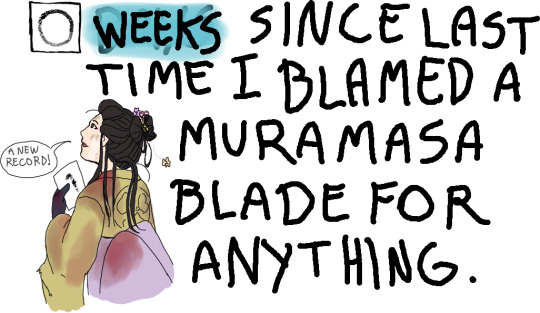
Everyone on the Touken Ranbu fandom probably is already familiarized with the Muramasa curse, but here I go:
Muramasa blades were common back at the Sengoku Period and almost anyone had one, but Tokugawa Ieyasu eventually banned the Muramasa blades due to the fact he believed the Muramasa curse was meant to finish off his lineage and all the branches of his clan.
Matsudaira Kiyokatsu was the first Matsudaira clan member to die by a Muramasa blade, killed by his own vassal. Then, his son, Matsudaira Hirotada, was murdered by a Muramasa blade. Tokugawa Ieyasu, Hirotada’s son, is known for hurting himself with a Muramasa blade he had in his possession when he was a child. One of Ieyasu’s sons (Matsudaira Nobuyasu) was ordered to commit suicide to take out all the false accusations of plotting with the Takeda clan against Oda Nobunaga and the blade used to assist his suicide by beheading him was a Muramasa too.
Naomasa was made for Lady Aoki, wife of Matsudaira Kiyokatsu, but she ended up being a item hanging on Kiyokatsu’s chambers. It’s known that she never left the Matsudaira clan, since the Tokugawa lineage descends from the Matsudaira. Even knowing that it could be just a coincidence, she indeed believed the curse was linked with the end of the Matsudaira clan. The reason that I decided to draw her bloodied is: being injured and not blaming a Muramasa blade for it, as a Matsudaira, shows at least a bit of understanding towards the fact that Muramasa blades were popular back when the whole curse rumors started, and this could be a enormous coincidence instead of a curse.
But, she is still salty sad about the fact that both Kiyokatsu and Hirotada were murdered by his own vassals which had Muramasa blades, making it hard to believe this isn’t linked to the curse at all.
2 notes
·
View notes
Text
“Some guy named Yaheiji”
As the story goes, before the Lady Ikoma becomes Nobunaga’s consort, she was married to a “Tsuchida Yaheiji”. This Tsuchida died, and Lady Ikoma went home to her parents, and that was when she met Nobunaga.
That story was told in the Bukouyawa text, which as I previously reported, the Ikoma family has now declared to be complete nonsense. In the Ikoma family official genealogy, Yaheiji’s surname was not recorded.

The segment highlighted in yellow says: 初何某弥平次 嫁ス後織田右府之
“First married to a certain Yaheiji, afterwards married to Oda Ufu (Nobunaga)”
*) 右府 Ufu refers to the post of the Minister of the Right.
You can also see that the lady’s name herself is not even listed here, which is why I’ve now switched to referring to her as Lady Ikoma and not the popularised (presumably fictive) name “Kitsuno”. I only maintain Kitsuno as a tag for archive purposes in this blog, because there’s too many posts to update if I were to change the tag.
The current Ikoma family representative said that he suspects “Yaheiji” is actually the man who will later be known as Akechi Hidemitsu, as he was previously known as Miyake Yaheiji. The reasoning for why the real surname is omitted is perhaps because during Hideyoshi’s reign, they feared they would be affected negatively for having former associations with the Akechi family.
As a comparison, her daughter Gotoku’s husband was very clearly recorded as “Okazaki Saburou Nobuyasu” 岡崎三郎信康
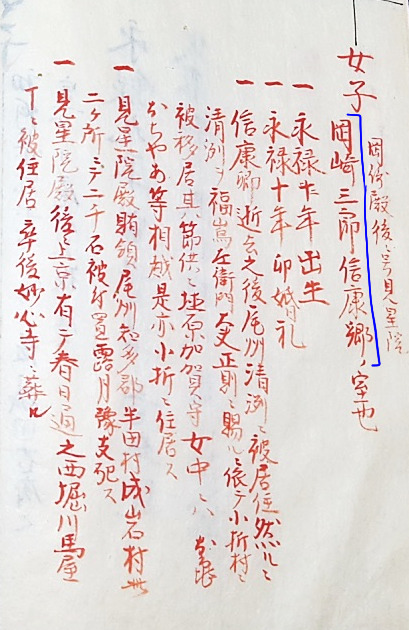
*) Ieyasu’s son Nobuyasu supposedly goes by “Okazaki Saburou” instead of “Tokugawa” in honour of his grandfather Matsudaira Hirotada, who also had used the same “Okazaki Saburou” name.
#ikoma kitsuno#samurai#artifacts#genealogy#ikoma clan#ikoma family#sengoku#Sengoku Era#Sengoku period#Warring states#Warring States Period#Warring States Era
5 notes
·
View notes
Text
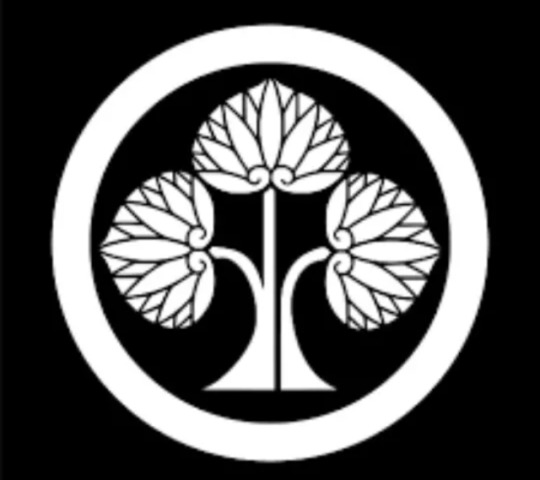
Honda clan
The Honda clan is a Japanese family that claims descent from the medieval court noble Fujiwara no Kanemichi. The family settled in Mikawa and served the Matsudaira clan as retainers. Later, when the main Matsudaira family became the Tokugawa clan, the Honda rose in prestige. The clan includes thirteen branches who had daimyo status, and forty-five who had hatamoto status. Arguably the most famous member of the Honda clan was the 16th century samurai general Honda Tadakatsu. Two of the major branches of the clan claim descent from Tadakatsu, or his close relative Honda Masanobu.
*Prominent People*
*Honda Tadakatsu* (1548 –1610) Honda Tadakatsu was one of the Tokugawa Four "Heavenly Kings" along with Ii Naomasa, Sakakibara Yasumasa and Sakai Tadatsugu. Ieyasu promoted him from daimyo of the Ōtaki han (100 000 koku) to the Kuwana han (150 000 koku) as a reward for his service. In addition, his son Honda Tadatomo became daimyo of Ōtaki. In 1609, he retired, and his other son Tadamasa took over Kuwana. His grandson, Tadatoki, married the granddaughter of Tokugawa Ieyasu, Senhime. Despite his years of loyal service, Tadakatsu became increasingly estranged from the Tokugawa shogunate(bakufu) as it evolved from a military to a civilian political institution. This was a fate shared by many other warriors of the time, who were not able to make the conversion from the chaotic lifetime of warfare of the Sengoku period to the more stable peace of the Tokugawa shogunate.
Such was Honda's reputation that he attracted notice from the most influential figures in Japan at the time. Oda Nobunaga, who was notoriously disinclined to praise his followers called him a "samurai among samurai". Moreover, Toyotomi Hideyoshi noted that the best samurai were "Honda Tadakatsu in the east and Tachibana Muneshige in the west". Even Takeda Shingen praised Honda, saying that "he is a luxury of Tokugawa Ieyasu". It was widely acknowledged that he was a reputed samurai and a loyal retainer of Tokugawa Ieyasu.
Tadakatsu is often referred to as "The Warrior who surpassed Death itself" because he never once suffered a significant wound, despite being the veteran of over 100 battles by the end of his life,and because he was never defeated by another samurai. In theater and other contemporary works, Tadakatsu is often characterized as polar opposite of Ieyasu's other great general, Ii Naomasa. While both were fierce warriors of the Tokugawa, Tadakatsu's ability to elude injury is often contrasted with the common depiction of Naomasa enduring many battle wounds, but fighting through them.
*Honda Tadatomo* ( 1582 – 1615) Tadatomo was the younger son of the famous Honda Tadakatsu
During the year 1615, Tadatomo fought very valiantly during the Battle of Tennōji. He led an attack that led to the death of Sanada Yukimura. Tadatomo himself did not survive the battle.
*Honda Tadamasa* ( 1575 – 1631) Tadamasa was the son of Honda Tadakatsu. Tadamasa's first battle was during the Siege of Odawara, in 1590; he also fought at the Battle of Sekigahara in 1600. After his father's retirement in 1609, he succeeded to the Honda family headship, becoming the second generation lord of the Kuwana Domain. Several years later, he took part in the Siege of Osaka, and received the Himeji Domain, with 150,000 koku of revenues, as a reward.
Tadamasa's wife was Kumahime, the daughter of Tokugawa Ieyasu's eldest sonMatsudaira Nobuyasu. Their eldest son,Honda Tadatoki (the husband of Tokugawa Hidetada's daughter Senhime), was in line to inherit the Himeji Domain. However, as Tadatoki died in 1626, at age 31, the domain went to his younger brother, Honda Masatomo.
*Honda Tadatoki* (1596–1626) Tadatoki was born as the eldest son of Honda Tadamasa. His mother Kumahime was a granddaughter of Tokugawa Ieyasu and Oda Nobunaga.
In 1616, Tadatoki married Senhime, another granddaughter of Ieyasu, and who had been married to Toyotomi Hideyori before Hideyori's death the Siege of Osaka. As adowry of his new bride, Tadatoki received 100,000 koku.
Tadatoki also sponsored the swordsman Miyamoto Musashi for a time. Musashi taught swordsmanship to Tadatoki's retainers; Musashi's adopted son Mikinosuke served Tadatoki as a page.
Tadatoki died of tuberculosis in 1626. Miyamoto Mikinosuke committed junshi soon afterward, choosing to follow his lord in death
*Komatsuhime*(AKA Inahime) (1573 –1620) Born the daughter of Honda Tadakatsu, she was adopted by Tokugawa Ieyasu, before marrying Sanada Nobuyuki. Komatsuhime was known in her childhood as Inahime and also Onei. After witnessing the martial prowess of the Sanada at the Battle of Ueda, she and her father were captivated by them. Tokugawa Ieyasu himself arranged for Komatsuhime to marry Sanada Nobuyuki, the son of the Sanada lord.
In 1600, when Nobuyuki had decided to cast his lot with the Tokugawa, his father Masayuki (who had not done so) was en route to Ueda Castle, accompanied by his other son, the famed Sanada Yukimura. The two stopped at Numata Castle, where Komatsuhime was managing affairs. Masayuki relayed a message to her: "I want to see my grandchildren," and in response, the princess emerged, dressed in full battle attire, saying "Since we have parted ways in this conflict, though you are my father-in-law I cannot allow you into this castle."Masayuki and Yukimura withdrew to a temple, Shōkaku-ji, and were surprised when they saw Komatsuhime (with her children) arrive soon after them, honoring Masayuki's wish.
After the Battle of Sekigahara, during Masayuki and Yukimura's exile, she took charge of sending them food and other daily necessities.
Komatsuhime was praised as a good wife and wise mother . She died in Kōnosu, Musashi Province at age 47, while en route to the Kusatsu hot spring.Nobuyuki lamented her death, saying that "the light of my house has been extinguished."
2 notes
·
View notes
Note
Hello! Is it possible to ask for a list of the twitter accounts of all the toumyu actors? I would like to stalk-, i mwan follow them
Hiya! :D Below are the Twitter accounts of the actors from the “Musical Touken Ranbu” listed according to the production that they made (or will be making) their first appearance in.
Trial Performance / Atsukashiyama Ibun
Kuroba Mario (Mikazuki Munechika): HEREKitazono Ryo (Kogitsunemaru): HERESakiyama Tsubasa (Ishikirimaru): N/ASaeki Daichi (Iwatooshi): HEREOhira Shunya (Imanotsurugi): HERESato Ryuji (Kashuu Kiyomitsu): HERE
Tanaka Shigemi (Musashibou Benkei): HEREKako Lion (Fujiwara no Yasuhira): HEREOkuno Masaaki (Minamoto no Yoritomo): HEREAraki Kentarou (Minamoto no Yoshitsune): HERE
Bakumatsu Tenrouden
Torigoe Yuki (Yamatonokami Yasusada): HEREArisawa Shoutarou (Izuminokami Kanesada): HEREOgoe Yuuki (Horikawa Kunihiro): HERETakahashi Kensuke (Hachisuka Kotetsu): HEREImari Yu (Nagasone Kotetsu): HERE
Goumoto Naoya (Kondo Isami): N/ATakagi Tomoyuki (Hijikata Toshizou): HERETochihara Rakuto (Okita Souji): HERE
Mihotose no Komoriuta
Araki Hirofumi (Nikkari Aoe): HEREspi (Tonbokiri): HEREYokota Ryugi (Monoyoshi Sadamune): HEREZaiki Takuma (Ookurikara): HEREOta Motohiro (Sengo Muramasa): HERE
Washio Noboru (Tokugawa Ieyasu): HEREOhno Mizuki (Matsudaira Nobuyasu): HEREAyuba Shuri (Takechiyo): N/AKojima Yukito (Takechiyo): N/ATakane Masaki (Gohei): HERE
Tsuwamono Domo ga Yume no Ato
Miura Hiroki (Higekiri): HERETakano Akira (Hizamaru): HERE
New Production (Spring 2018)
Sakamoto Shogo (Horikawa Kunihiro): HEREKiyama Haruki (Tomoegata Naginata): HERETamura Shin (Mutsunokami Yoshiyuki): HERE
Enjoy stalk- uh, I mean, following them? xDDDD
109 notes
·
View notes
Photo
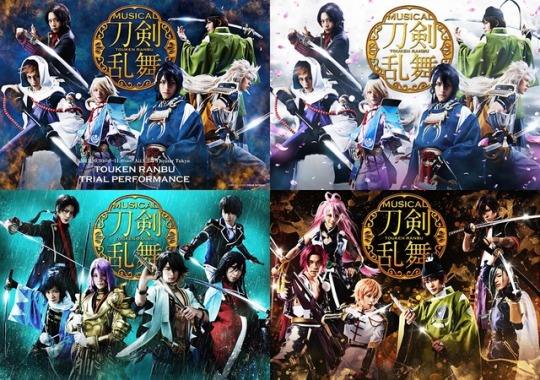


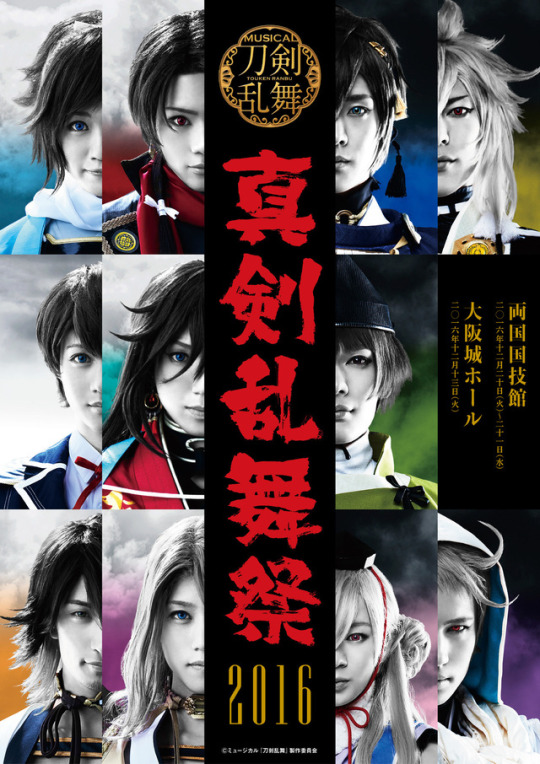
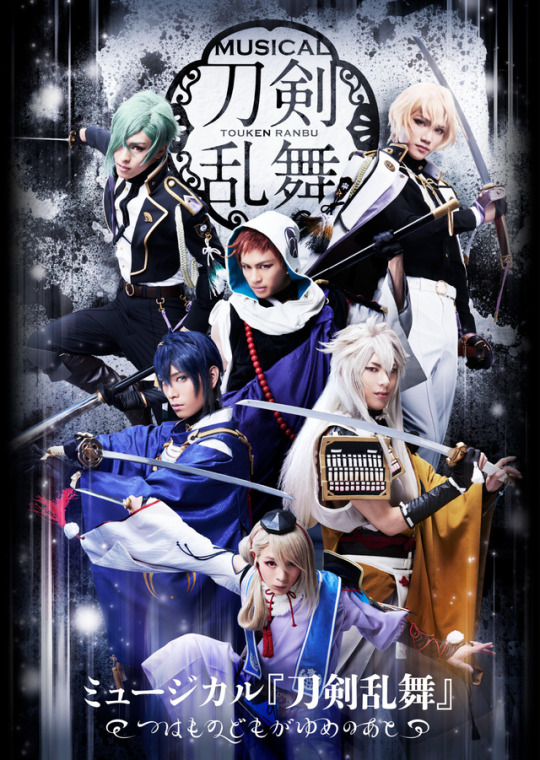

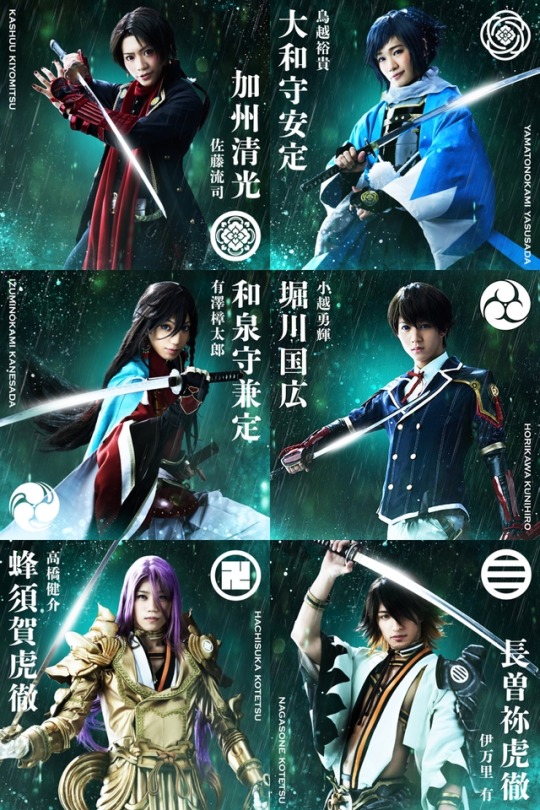


ミュージカル『刀剣乱舞』/ Musical Touken Ranbu :
Trial Performance / トライアル公演 ( Autumn 2015 )
Atsukashiyama ibun / 阿津賀志山異聞 ( Spring 2016)
Bakumatsu tenrouden / 幕末天狼傳 ( Autumn 2016 )
in Itsukushima Shrine / in 嚴島神社 ( Autumn 2016 )
Shinken Ranbu Sai 2016 / 真剣乱舞祭 2016 ( Winter 2016 )
Mihotose no Komoriuta / 三百年の子守唄 ( Spring 2017 )
Kashuu Kiyomitsu Tanki Shutsujin 2017 (Kashuu Kiyomitsu solo live) / 加州清光 単騎出陣2017 ( Autumn 2017 )
Tsuwamono domo ga yume no ato / ~つはものどもがゆめのあと~ ( Autumn 2017 )
Shinken Ranbu Sai 2017 / 真剣乱舞祭 2017 ( Winter 2017 )
Performance Dates:
Trial Performance : 17 performance within 10 days, 0 days off
Tokyo : October 30, 2015 - November 8, 2015
Atsukashiyama ibun : 40 performance within 22 days, 2 days off
Tokyo: May 27, 2016 - June 12, 2016
Osaka : June 17, 2016 - June 19, 2016
Kyoto: June 23, 2016 - June 26, 2016
Bakumatsu tenrouden : 65 performance within 39 days, 4 days off
Tokyo: September 24, 2016 - October 10, 2016
Fukuoka: October 15, 2016 - October 16
Osaka: October 21, 2016 - October 30, 2016
Tokyo: November 17, 2016 - November 27, 2016
Shanghai: January 13, 2017 - January 15, 2017
in Itsukushima Shrine : 2 performance within 1 day
November 12, 2016
Shinken Ranbu Sai 2016 : 6 performance
Osaka : December 13, 2016
Tokyo : December 20, 2016 - December 21, 2016
Mihotose no Komoriuta : 65 performance within 40 days, 5 days off
Tokyo: March 4, 2017 - March 26, 2017
Osaka : April 1, 2017- April 9, 2017
Tokyo: April 14, 2017 - April 23, 2017
Zhuhai : May 19, 2017 - May 21, 2017
Kashuu Kiyomitsu Tanki Shutsujin 2017 : 16 performance within 10 days, 1 day off
Tokyo: October 5, 2017 - October 15, 2017
Tsuwamono domo ga yume no ato : 36 performance within 24 days, 2 days off
Tokyo: November 4, 2017 - November 12, 2017
Kyoto: November 17, 2017 - November 19, 2017
Tokyo: January 6, 2018 - January 14, 2018
Osaka: January 26, 2018 - January 30, 2018
Shinken Ranbu Sai 2017 : 11 performance
Tokyo : December 8, 2017 - December 9, 2017
Osaka : December 12, 2017 - December 13, 2017
Saitama: December 19, 2017 - December 20, 2017
Guangzhou : December 23, 2017 - December 24, 2017
Place used:
Tokyo:
AiiA 2.5 Theater Tokyo : Trial Performance, Atsukashiyama ibun, Bakumatsu tenrouden, Mihotose no Komoriuta,
Ryougoku Kokugikan : Shinken Ranbu Sai 2016
Tennouzu Ginga Gekijou - The Galaxy Theatre: Kashuu Kiyomitsu Tanki Shutsujin 2017
Nippon Budokan : Shinken Ranbu Sai 2017
Tokyo Dome City Hall : Tsuwamono domo ga yume no ato
Nippon Seinenkan Hall : Tsuwamono domo ga yume no ato
Osaka:
Morinomiya Piloti Hall : Atsukashiyama ibun, Bakumatsu tenrouden
Sankei Hall Breeze: Bakumatsu tenrouden
Osakajo Hall : Shinken Ranbu Sai 2016 , Shinken Ranbu Sai 2017
Umeda Arts Theater: Mihotose no Komoriuta, Tsuwamono domo ga yume no ato
Kyoto:
Kyoto Gekijo: Atsukashiyama ibun, Tsuwamono domo ga yume no ato
Fukuoka:
Fukuoka Canal City theater: Bakumatsu tenrouden
Saitama:
Saitama Super Arena: Shinken Ranbu Sai 2017
China:
Shanghai Hongqiao Culture Artistic Center: Bakumatsu tenrouden
Zhuhai Grand Theatre : Mihotose no Komoriuta
Guangzhou Stadium: Shinken Ranbu Sai 2017
Touken Danshi Actors:
Kuroba Mario ( 黒羽麻璃央 ) as Mikazuki Munechika
Kitazono Ryo ( 北園涼 ) as Kogitsunemaru
Sakiyama Tsubasa ( 崎山つばさ) as Ishikirimaru
Saeki Daichi ( 佐伯大地 ) as Iwatooshi
Ohira Shunya ( 大平峻也 ) as Imanotsurugi
Sato Ryuji ( 佐藤流司 ) as Kashuu Kiyomitsu
Torigoe Yuuki ( 鳥越裕貴 ) as Yamatonokami Yasusada
Arisawa Shoutarou ( 有澤樟太郎 ) as Izuminokami Kanesada
Ogoe Yuuki ( 小越勇輝 ) as Horikawa Kunihiro
Takahashi Kensuke ( 高橋健介 ) as Hachisuka Kotetsu
Imari Yuu ( 伊万里有 ) as Nagasone Kotetsu
Araki Hirofumi ( 荒木宏文 ) as Nikkari Aoe
Ota Motohiro ( 太田基裕 ) as Sengo Muramasa
Spi as Tonbokiri
Yokota Ryugi ( 横田龍儀 ) as Monoyoshi Sadamune
Zaiki Takuma ( 財木琢磨 ) as Ookurikara
Miura Hiroki ( 三浦宏規 ) as Higekiri
Takano Akira ( 高野洸 ) as Hizamaru
Human Team Actors:
Atsukashiyama ibun / Trial Performance :
Tanaka Shigemi (田中しげ美) as Musashibou Benkei
Araki Kentarou (荒木健太朗) as Minamoto no Yoshitsune
Okuno Masaaki (奥野正明) as Minamoto no Yoritomo
Kako Lion (加古臨王) as Fujiwara no Yasuhira
Bakumatsu tenrouden :
Goumoto Naoya (郷本直也) as Kondou Isami
Takagi Tomohiro (高木トモユキ) as Hijikata Toshizou
Tochihara Rakuto (栩原楽人) as Okita Souji
Mihotose no Komoriuta :
Washio Noboru (鷲尾 昇) as Tokugawa Ieyasu
Ohno Mizuki (大野瑞生) as Matsudaira Nobuyasu
Ayuba Shuri (阿由葉朱凌) / Kojima Yukito (小島幸士) as Takechiyo (W cast)
Takane Masaki (高根正樹) as Gohei
Tsuwamono domo ga yume no ato:
Tanaka Shigemi (田中しげ美) as Musashibou Benkei
Araki Kentarou (荒木健太朗) as Minamoto no Yoshitsune
Tomita Masanori (冨田昌則) as Minamoto no Yoritomo
Kako Lion (加古臨王) as Fujiwara no Yasuhira
Touken Danshi Appearance:
Atsukashiyama ibun / Trial Performance :
Mikazuki Munechika
Kogitsunemaru
Ishikirimaru
Iwatooshi
Imanotsurugi
Kashuu Kiyomitsu
Bakumatsu tenrouden :
Kashuu Kiyomitsu
Yamatonokami Yasusada
Izuminokami Kanesada
Horikawa Kunihiro
Hachisuka Kotetsu
Nagasone Kotetsu
in Itsukushima Shrine :
Mikazuki Munechika
Kogitsunemaru
Ishikirimaru
Iwatooshi
Imanotsurugi
Kashuu Kiyomitsu
Yamatonokami Yasusada
Izuminokami Kanesada
Horikawa Kunihiro
Hachisuka Kotetsu
Nagasone Kotetsu
Shinken Ranbu Sai 2016 :
Mikazuki Munechika
Kogitsunemaru
Ishikirimaru
Iwatooshi
Imanotsurugi
Kashuu Kiyomitsu
Yamatonokami Yasusada
Izuminokami Kanesada
Horikawa Kunihiro
Hachisuka Kotetsu
Nagasone Kotetsu
Mihotose no Komoriuta :
Ishikirimaru
Nikkari Aoe
Sengo Muramasa
Tonbokiri
Monoyoshi Sadamune
Ookurikara
Tsuwamono domo ga yume no ato :
Mikazuki Munechika
Kogitsunemaru
Iwatooshi
Imanotsurugi
Higekiri
Hizamaru
Shinken Ranbu Sai 2017 :
Mikazuki Munechika
Kogitsunemaru
Ishikirimaru
Iwatooshi
Imanotsurugi
Kashuu Kiyomitsu
Izuminokami Kanesada
Hachisuka Kotetsu
Nagasone Kotetsu
Nikkari Aoe
Sengo Muramasa
Tonbokiri
Monoyoshi Sadamune
Ookurikara
Higekiri
Hizamaru
Other:
NHK’s Shibuya Note:
(September 4, 2016) Team Sanjou with Kashuu Kiyomitsu
(July 2, 2017) Team Shinsengumi with Hachisuka Kotetsu (without Horikawa Kunihiro, Nagasone Kotetsu)
(September 30, 2017) Formation of Mihotose
INDIA GAMING SHOW:
(February 4, 2017 - February 5, 2017) Team Shinsengumi with Hachisuka Kotetsu
Japan Expo Paris 2017:
(July 7, 2017 - July 8, 2017) Team Sanjou with Kashuu Kiyomitsu (without Mikazuki Munechika)
Music Videos:
Team Sanjou with Kashuu Kiyomitsu: 『キミの詩』 / “Kimi no Uta”
Team Shinsengumi with Hachisuka Kotetsu: 『ユメひとつ』/ “Yume Hitotsu”
Formation of Mihotose: 『勝利の凱歌』 / “Shouri no Gaika”
OFFICIAL SITE :
Here
#just some toumyu things#compilation of information?#toumyu#musical touken ranbu#touken ranbu musical#what am I missing?#I hope I didn't get any info wrong#took me a while#hahaha
177 notes
·
View notes
Note
hello there~ ^^ i'm new to touken ranbu fandom since i watched hanamaru (i fell in love with the swords lol) & katsugeki XD now i'm wondering if the touken ranbu musicals have good plot/storylines and songs too?? i am planning to buy touken ranbu anime dvds/cds and i am tempted to buy & watch the musical dvds too but i want to know your opinion about the musicals first if you can do a short review about them. ^^ thank you i hope you can answer this too, arigato
Hi anon! Sorry for the late response as I did see this yesterday but I had a lot going on! But now I’ll be able answer~ I have only watched Hanamaru (as I haven’t had the time to see Katsugeki yet *cries*) and it gives you some of the backgrounds of some of the swords from their history.
I can tell you that for the Musical Touken Ranbu (Toumyu) Brand, the storylines are really good as well as the little Lives they have at the end of each show! There’s also Butai Touken Ranbu (Tousute) but that’s more performance based as they only sing the at the beginning and end of the shows…
I will give you a little of review of each Toumyu show that they have brought out on DVD so far! All will be under the cut: (It took me all day to write this as I did some research also xD)
So far there have been 6 performances brought out on DVD as one is currently on stage, another will be on in December (which is a Live performance) and there’s a Solo Live that finished in October but the DVD doesn’t come out until next year I believe. 2 are Live performances, 4 of them are Musical based that have the Lives at the end! Just be aware that my history in Japan still isn’t that great yet (hence the research). So I can only go off what I have seen whist watching the musicals and from what I’ve found xD
The Trial Performance:
This was the first ever Toumyu performance in 2015. The team in this Musical is called ‘Team Sanjou with Kashuu Kiyomitsu’. Which consists of the swords Mikazuki Munechika, Kogitsunemaru, Imanotsurugi, Iwatooshi, Ishikirimaru and the Captain Kashuu Kiyomitsu. It follows through the story of Mt. Atsukashi with Minamoto no Yoritomo who was the head of the Minamoto Clan, attempting to kill his younger brother who was the military commander, Minamoto no Yoshitsune after Fujiwara no Yasuhira betrayed him and giving into the pressure and following Yoritomo. Which lead to Yasuhira and his troops surrounding the Koromogawa-no-tachi residence and killing Yoshitsune’s troops and his retainer Musashibo Benkei. In the end Yasuhira didn’t kill Yoshitsune, he (Yoshitsune) committed seppuku which means he killed himself with honor rather than falling into the enemies hands.
But within the musical, Team Sanjou with Kashuu Kiyomitsu have to go back to that time period to stop the History Revolutionist Army from keeping Minamoto no Yoshitsune alive. But when they arrive in that time, he is still alive and this causes Imanotsurugi to be in conflict since his former master is alive and he wants to be with him again. But Iwatooshi is trying to keep him from changing history, even though he doesn’t want to make him not see his former master, but by seeing him it could change history. There is also conflict between team members Kashuu Kiyomitsu and Ishikirimaru since Kashuu tends to follow the ways of the Shinsengumi since he was Okita Souji’s sword. But Ishikirimaru is trying to get Kiyomitsu to see that they aren’t the Shinsengumi and that Imanotsurugi is experiencing conflict during this mission. So overall this musical is really good and the songs throughout follow through with the story line and with what everyone is feeling. The Live portion too is really good for the first ever Toumyu muscial as well as their outfits!
Atsukashiyama Ibun:
This one is a reprise of the Trial Performance following the same story and teams that was performed in 2016. The songs in the musical are still the same but they have improved and they have also added in a few new songs in the Musical that are not in the Trial Performance. The Live in this musical does have some songs that are in the Trial Performance Live, including the outfits; but the majority of it is all new songs! So it’s really good to watch after seeing the Trial Performance as then you can see what’s different and it’s just as good as the Trial!
Bakumatsu Tenrouden:
This Musical is a new team and a new story that was also done in 2016! The team is called ‘Team Shinsengumi with Hachisuka Kotetsu’ which consists of the swords Kashuu Kiyomitsu, Yamatonokami Yasusada, Izuminokami Kanesada, Horikawa Kunihiro, Nagasone Kotetsu and the Captain Hachisuka Kotetsu. This follows through the period of Bakumatsu which is the end of the Edo period when the Tokugawa shogunate ended. But the musical begins during the middle of the Ikeda Inn incident where Okita had fallen ill with Tuberculosis which was first discovered during the incident. And the story ends when it comes to the execution of the Shinsengumi Commander Kondo Isami.
When the Team goes back into that time period, they go back to before the Shinsengumi existed to see how they became the infamous group. As the Team have no idea who the History Revolutionist Army were targeting in the group. But there’s conflict between both Kashuu and Yamatonokami since during the Ikeda Inn Incident, Okita was using Kashuu during the siege. Yasusada was left behind. So Yasuda wants to be with Okita by joining the Shinsengumi as they believe that the History Revolutionist Army could target them at any time. Kashuu tries to talk Yasusada out of it but then it causes even more conflict between them. But they allow Yasusada to go and join the Shinsengumi but he has to hide his identity and live among the group as well as try not to go near Okita Souji. But there are points where Yasusada wants to give Okita a medicine that can help cure him of his condition. But he has inner conflict with himself as he knows he can’t do it as he will be doing the same thing as his enemy. There’s also conflict between Nagasone and Hachisuka. Hachisuka never sees Nagasone as part of his family and believe he’s better than the ‘fake’ and can never get along with him, yet understand what he’s thinking. The songs in the musical are catchy and it allows you to see the inner conflict with Yasusada and between both Kotetsu’s. The Live performance is also a REAL good one too! All new songs and the outfits are amazing!
Itsukushima Jinja:
This one is a live performance but the DVD for this come out in August this year! This was performed for one night I believe in November 2016. This consists of some of the songs from the Atsukashiyama Ibun & Bakumatsu Tenrouden Musicals. Plus some of from their lives also. Their outfits are amazing and it really is a beautiful performance! But if you’d like to see my little review, you can find that over here!
Shinken Ranbu Sai 2016:
This is an annual group live that involved Team Sanjou and Team Shinisengumi. It also includes those that were in the musicals (Atsukashiyama: Yoshitsune, Yoritomo, Yasuhira & Benkei - Bakumatsu: Kondou Isami, Okita & Hijikata). But there is a little story in this live. Since Kashuu was the Catpain of Team Sanjou and he’s also part of Team Shinsengumi, they are both wanting Kashuu. Thus the live consists of trying to convince Kashuu to pick between either his team that he’s part of in the Shinsengumi, or the team that allowed him to be leader. It consists of songs from both musicals and lives and they sing in both their battle and live outfits! This DVD came out in April which was before Itsukushima Jinja, but the actual performance dates are different since this was in December last year when it was performed.
Mihotose no Konmori-Uta:
This was performed in April this year! This is made of a new Team that’s called ‘Touken Danshi Formation of Mihotose’ that consists of the Captain Ishikirimaru, Nikkari Aoe, Sengo Muramasa, Tonbokiri, Monoyoshi Sadamune and Ookurikara. I’m still trying to wrap my head around the story of this Musical since it’s different from the rest. It’s basically tells the story about how they came to be part of history. It starts when Ookurikara and Nikkari were on an expedition when they noticed the Okazaki Castle was under attack by the History Revolutionist Army that wiped out the Matsudaira clan from history and only one child survived by the name of Matsudaira Takechiyo (who grows up to become Tokugawa Ieyasu). The group then decide to help continue the flow of history by raising him and making sure history follows the same pattern it was meant to be. The team became Ieyasu’s retainers who would help him out in battle (Ishikirimaru: Hanzo, Monoyoshi: Mototada, Tonbokiri: Tadakatsu, Ookurikara: Yasumasa, Nikkari: Tadatsugu, whereas Muramasa didn’t want to help so he watched in the shadows) . He then changes his name to Matsudaira Motoyasu who has his first son, Matsudaira Nobuyasu.
Nobuyasu grows up and he wishes to no longer fight in this war, but his father forbids it. But in history, Hanzo is meant to execute Nobuyasu since they believe that he committed treason, but it was not true. However in the musical, Hanzo has to kill Nobuyasu in order to keep the flow of history in order, but he couldn’t do it. So in this musical it’s more of a story about their mission together that involves a lot of inner conflict in Ishikirimaru which let’s us know more about why he hates war. And his Team also do have some little conflicts when taking on this mission, but they follow though without any doubts. The live part is also good! Overall, the songs in this musical do tend to repeat a little bit, but that’s because the title is called the ‘3000 Year Lullaby’, which is why you hear one of the songs a few times in the musical, but it’s overall a really good musical! It actually made me cry in all honesty >
Some of the other performances that have finished/still running/or will be starting soon are:
Kashuu Kiyomitsu’s Solo Live: The DVD comes out some time early next year and I can tell you from what I’ve heard, there are new songs and live outfits since it’s only Kashuu on the front lines.Tsuwamonodomo ga yume no ato: This is currently on stage and it does seem to follow the Minamoto clan and their battles from some of the little parts I’ve seen on YouTube thanks to the reporters who get to see the dress rehearsal before the opening show. Shinken Ranbu Sai 2017: This will be starting in December that will involve ALL of the teams (Sanjou, Shinsengumi & Mihotose) but sadly due to other work, the actors who play Yasusada and Horikawa won’t be participating in the show this year.
I hope I have been able to convince you to get the DVDs for yourself! Even if you just get the Trial Performance and watch that first, if you like it, then proceed to buy the others and watch them! ❤ :D
29 notes
·
View notes
Photo
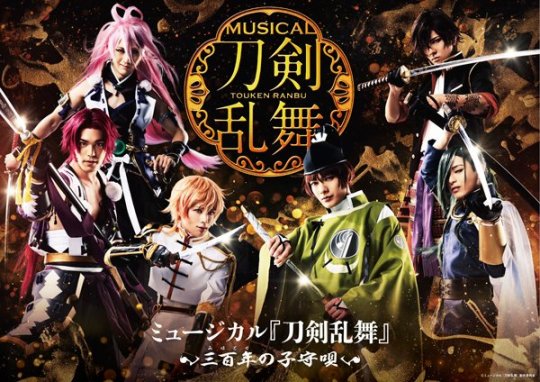
[DDL] MUSICAL TOUKEN RANBU-MIHOTOSE NO KOMORIUTA-**
Pretty sure it’s been shared by someone but I really want to share this too so XD
CAST :
Ishikirimaru = Sakiyama Tsubasa
Nikkari Aoe = Araki Hirofumi
Sengo Muramasa = Oota Motohiro
Tonbokiri = Spi (William Worthington Spearman 4th)
Monoyoshi Sadamune = Yokota Ryugi
Ookurikara = Zaiki Takuma
Tokugawa Ieyasu = Washio Noboru
Matsudaira Nobuyasu = Ono Mizuki
Takechiyo/Tokugawa Iemitsu = Ayuba Shuuri/Kojima Yukito (W Cast)
Gohei = Takane Masaki
And Others
RULES :
DO NOT REUPLOAD INTO ANY STREAMING SITES (PARTS OR FULL)
DO NOT SHARE THE LINK OPENLY
Caps, gifs, or video cuts here on tumblr are completely okay*
If your friend interested in this musical, please direct them to this page
No empty blog. Post or at least reblogs or I will ignore you
State on your ask that you will follow all of the rules
I will only reply to ask, so don’t bother to send me message
Enjoy the musical^^
*I don’t put watermark on the video
**This file is ripped from blu-ray disc so if you want to watch this with English Sub please refer to Riku’s Engsub for blu ray HERE
**You will need HJSplit to join the files
Send me AN ASK off anon for the download link^^
177 notes
·
View notes